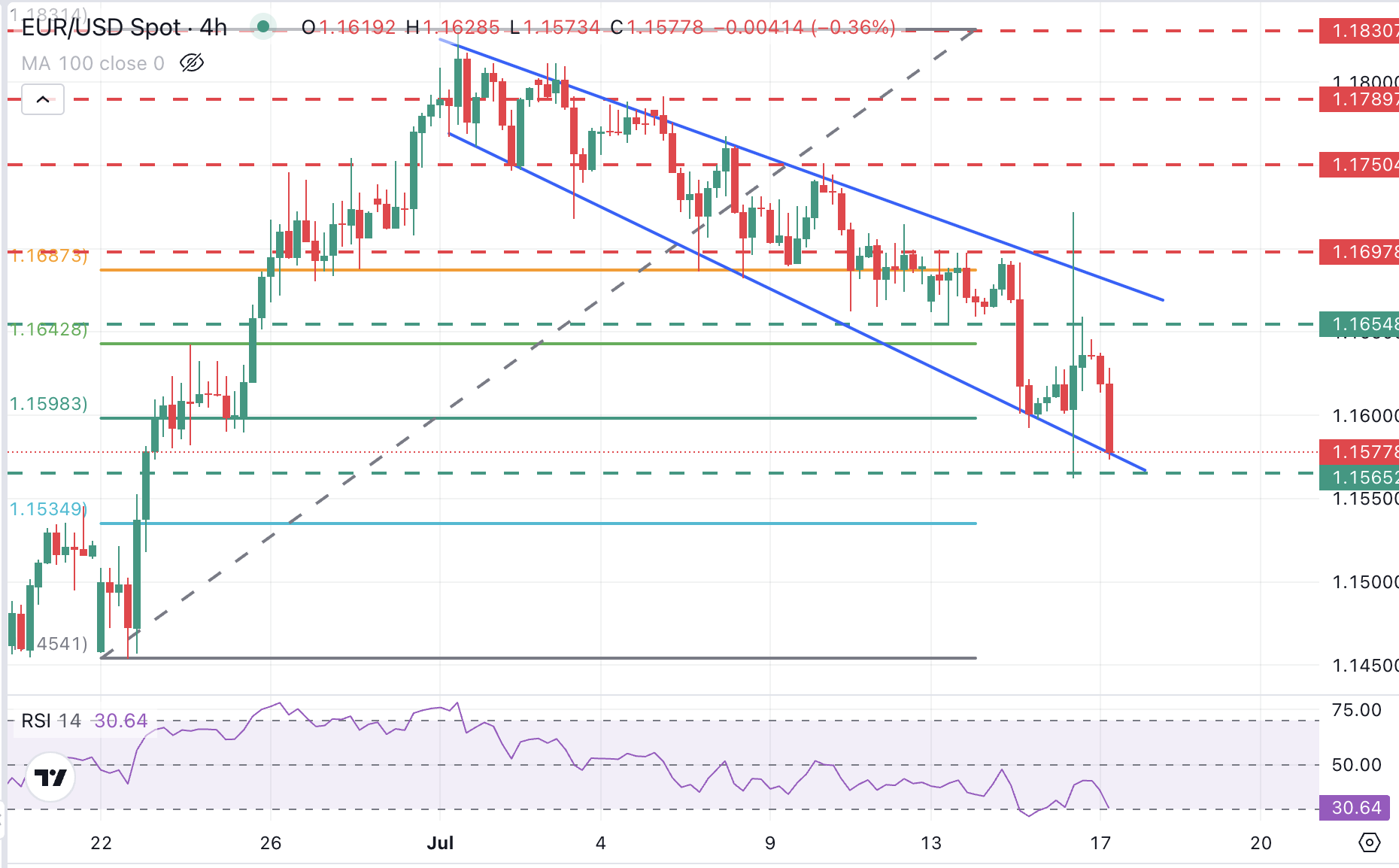
The Euro dives further as the safe-haven US Dollar outperforms amid a strong risk-off mood.
Speculation about the resignation of Fed Chair Powell rattled markets and triggered a rush for safety on Wednesday.
EUR/USD approaches multi-week lows at 1.1565 ahead of the Eurozone Inflation report.
The EUR/USD pair is trading lower on Thursday, with investors averse to risk after a turbulent US session on Wednesday as tensions between US President Donald Trump and Fed Chair Jerome Powell escalated. The safe-haven Dollar is outperforming its peers on Thursday, with investors awaiting Eurozone inflation and US Retail Sales data.
The Euro (EUR) extended losses on Thursday's European session opening, reaching session lows at 1.1575 at the time of writing, nearing three-week lows at 1.1565. The broader trend remains bearish, with price action trading at the bottom of the downtrend channel from July 1 highs at 1.1830.
US President Trump calmed traders on Wednesday, stating that he does not plan to fire Powell, as it would disrupt the market. However, he added that he would like him to resign, a possibility later denied by a Federal Reserve spokesperson. Trump also suggested the possibility of dismissing the Fed chief due to the overrun costs of the central bank's historic building in Washington, potentially on fraud charges.
The ongoing tensions between Trump and Powell have raised speculation that the Fed Chairman might be replaced by a more dovish one, which would bring higher inflation and, highly likely, erode investors' confidence in the independence of the central bank and, more broadly, in the US financial system.
On the macroeconomic front, the US Producer Price Index showed moderate inflation pressures, which alleviated fears from the hot CPI figures seen the previous day. On Thursday, the focus is on the Eurozone's consumer inflation report and the US Retail Sales figures to assess the impact of Trump's tariffs on consumption.
Euro PRICE Today
The table below shows the percentage change of Euro (EUR) against listed major currencies today. Euro was the strongest against the Australian Dollar.

The heat map shows percentage changes of major currencies against each other. The base currency is picked from the left column, while the quote currency is picked from the top row. For example, if you pick the Euro from the left column and move along the horizontal line to the US Dollar, the percentage change displayed in the box will represent EUR (base)/USD (quote).
Daily digest market movers: Euro wavers in range ahead of Eurozone CPI and US retail sales data
The highlight during the European session is June's Eurozone CPI report, which is expected to confirm preliminary figures that revealed a 2% year-on-year growth, up from May's 1.9%. The Core CPI was reported at 2.3% year-on-year in the preliminary reading, unchanged from May.
In the US, Retail Sales are expected to have increased 0.1% in June, following a 0.9% contraction in May. Excluding automobiles, sales of all other products are seen increasing 0.3% after a 0.3% contraction in May.
Beyond that, US Jobless Claims are expected to have increased to 235K from the previous week's 227K. The US Dollar needs low claims and strong consumption data to ease tariff concerns and endorse Fed Powell's "higher for longer" stance on interest rates.
On Wednesday, data from the US Bureau of Labor Statistics revealed that the US Producer Price Index stalled in June, with the year-on-year rate easing to a 2.3% growth from 2.6% in May. Likewise, the Core PPI was flat on the month and the yearly rate moderated to 2.6% from the previous month's 3% reading. These figures calmed fears of an inflation revival, which were triggered by Tuesday's CPI report.
Also on Wednesday, data from the Eurozone showed that the region's trade surplus widened well beyond expectations in May, increasing to EUR16.2 billion from EUR9.9 billion in the previous month, and beating expectations of a more moderate EUR13 billion surplus.
Italian CPI data has shown that inflation accelerated to 1.8% in the last 12 months to June, from the previous 1.7%. These figures are still below the European Central Bank's (ECB) 2% target, and therefore, the impact on the Euro has been marginal.
EUR/USD is at a key support area above 1.1565

EUR/USD is resuming its broader bearish trend in the early European session on Thursday. The pair is testing the support area between the support trendline, now at 1.1575, and Wednesday's low at 1.1565. The 4-hour RSI is low but not yet at oversold levels, which suggests that further depreciation is likely.
Further down, the Euro might find support at the 78.6% Fibonacci retracement of the late June bullish run at 1.1535, in the area where bulls were capped on June 20. Below here, the June 19 and 23 lows at around 1.1455 seem too far a target for today.
On the upside, resistances are at the previous support area 1.1655 (July 11, 14 lows) and now turned resistance. Further up, there is the channel's top at 1.1680 and the July 14 and 15 highs right below 1.1700.
* The content presented above, whether from a third party or not, is considered as general advice only. This article should not be construed as containing investment advice, investment recommendations, an offer of or solicitation for any transactions in financial instruments.


